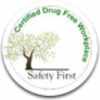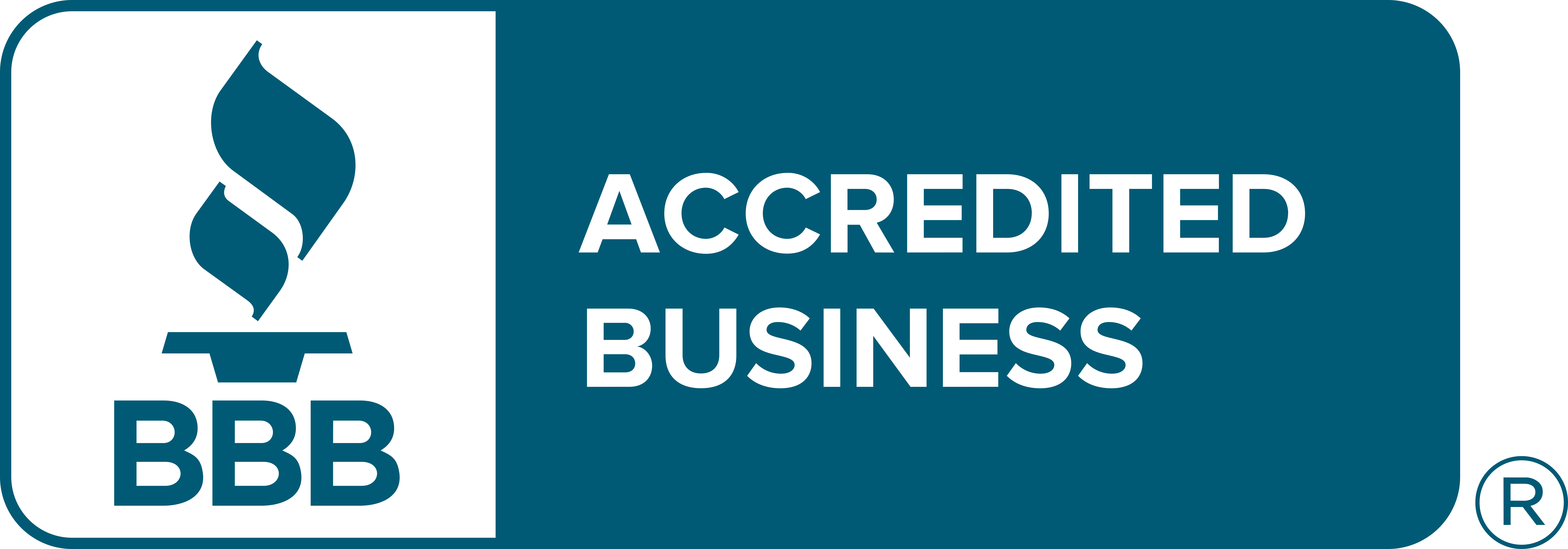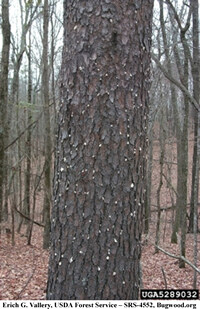 Description: The Southern Pine Beetle (SPB) is a native insect and a natural part of the Southeastern forest. It is also the most destructive pest of pines in this region. All pine species can be attacked, although, in our area, the shortleaf is more susceptible than the loblolly or Virginia. When SPB populations are low, the first attack will start in an unhealthy, weakened pine. As the SPB populations increase, healthy trees will succumb.
Symptoms: The first symptom typically noticed from a SPB infestation is the discoloration of the upper needles. The needles first fade to a dull green, then to yellow and finally to a reddish brown before defoliation. The earliest signs of a SPB attack is brownish-orange dust, produced when a female bores into the tree. Another indication is the presence of multiple popcorn sized lumps of resin or ‘pitch’ on the outer bark. The most diagnostic sign of SPB activity is found by exposing a portion of inner bark to reveal winding S-shaped galleries that cross each other and are filled with dust and frass.
Description: The Southern Pine Beetle (SPB) is a native insect and a natural part of the Southeastern forest. It is also the most destructive pest of pines in this region. All pine species can be attacked, although, in our area, the shortleaf is more susceptible than the loblolly or Virginia. When SPB populations are low, the first attack will start in an unhealthy, weakened pine. As the SPB populations increase, healthy trees will succumb.
Symptoms: The first symptom typically noticed from a SPB infestation is the discoloration of the upper needles. The needles first fade to a dull green, then to yellow and finally to a reddish brown before defoliation. The earliest signs of a SPB attack is brownish-orange dust, produced when a female bores into the tree. Another indication is the presence of multiple popcorn sized lumps of resin or ‘pitch’ on the outer bark. The most diagnostic sign of SPB activity is found by exposing a portion of inner bark to reveal winding S-shaped galleries that cross each other and are filled with dust and frass.
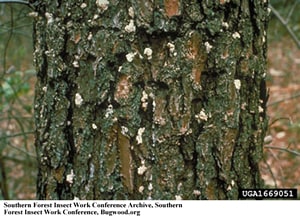 Adult SPB reach a mature length of only 1/8th of an inch, similar to a grain of rice. A few female adults begin with a mid-trunk attack on an unhealthy tree. Once they have successfully colonized, they produce a pheromone to attract others; resulting in a mass attack that overwhelms the tree. Resin under pressure acts as a natural defense and can stop an attack if only a few SPB are present and the tree is healthy. But by mass attack, the SPBs can deplete the resin production and overcome the tree. Mating follows the intrusion and the females begin to create the S-shaped galleries. Eggs are laid in niches within the gallery. Adults may reemerge after mating to continue the cycle in nearby trees. Eggs hatch within 3-9 days and the larvae feed in the inner phloem and also construct galleries. They tunnel towards the outer bark and within a month are adults themselves and bore an exit tunnel.
During gallery construction adult beetles introduce a blue-stain fungus that plugs the tree’s water transport system (xylem). Pines that have been successfully colonized are functionally dead within one day after attack. Infestations can spread by more than 50 feet per day, resulting in widespread forest devastation.
Adult SPB reach a mature length of only 1/8th of an inch, similar to a grain of rice. A few female adults begin with a mid-trunk attack on an unhealthy tree. Once they have successfully colonized, they produce a pheromone to attract others; resulting in a mass attack that overwhelms the tree. Resin under pressure acts as a natural defense and can stop an attack if only a few SPB are present and the tree is healthy. But by mass attack, the SPBs can deplete the resin production and overcome the tree. Mating follows the intrusion and the females begin to create the S-shaped galleries. Eggs are laid in niches within the gallery. Adults may reemerge after mating to continue the cycle in nearby trees. Eggs hatch within 3-9 days and the larvae feed in the inner phloem and also construct galleries. They tunnel towards the outer bark and within a month are adults themselves and bore an exit tunnel.
During gallery construction adult beetles introduce a blue-stain fungus that plugs the tree’s water transport system (xylem). Pines that have been successfully colonized are functionally dead within one day after attack. Infestations can spread by more than 50 feet per day, resulting in widespread forest devastation.
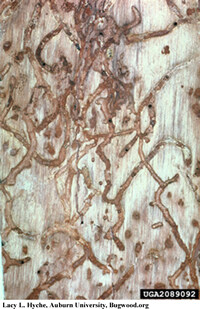 Action: Drought and damaging storms can cause optimal situations for outbreaks. However, many stress factors can be controlled. Plant more SPB resistant species. Thin overstocked stands. Plant a diverse variety of trees. Remove damaged and unhealthy pines. Provide supplemental water during drought conditions. Keep construction and logging damage to a minimum. When a SPB infestation has been confirmed, remove the host and potential hosts within 50 – 100 feet of the original.
Thank you for reviewing this information. Schneider Tree Care is committed to preserving and enhancing the quality of your property through tree care education and services. We employ professionally trained and certified arborists who are available to meet with you for a consultation at no charge. If you have any questions or need additional information regarding the health of your trees, please contact us.
Action: Drought and damaging storms can cause optimal situations for outbreaks. However, many stress factors can be controlled. Plant more SPB resistant species. Thin overstocked stands. Plant a diverse variety of trees. Remove damaged and unhealthy pines. Provide supplemental water during drought conditions. Keep construction and logging damage to a minimum. When a SPB infestation has been confirmed, remove the host and potential hosts within 50 – 100 feet of the original.
Thank you for reviewing this information. Schneider Tree Care is committed to preserving and enhancing the quality of your property through tree care education and services. We employ professionally trained and certified arborists who are available to meet with you for a consultation at no charge. If you have any questions or need additional information regarding the health of your trees, please contact us. 



